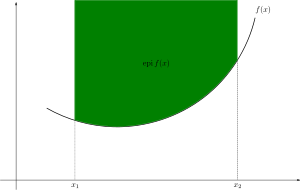Epigraph (mathematics)

In mathematics, the epigraph or supergraph[1] of a function f : Rn→R is the set of points lying on or above its graph:
The strict epigraph is the epigraph with the graph itself removed:
The same definitions are valid for a function that takes values in R ∪ ∞. In this case, the epigraph is empty if and only if f is identically equal to infinity.
The domain (rather than the co-domain) of the function is not particularly important for this definition; it can be any linear space[1] or even an arbitrary set[2] instead of  .
.
Similarly, the set of points on or below the function is its hypograph.
Properties
A function is convex if and only if its epigraph is a convex set. The epigraph of a real affine function g : Rn→R is a halfspace in Rn+1.
A function is lower semicontinuous if and only if its epigraph is closed.
References
- ↑ 1.0 1.1 Pekka Neittaanmäki; Sergey R. Repin (2004). Reliable Methods for Computer Simulation: Error Control and Posteriori Estimates. Elsevier. p. 81. ISBN 978-0-08-054050-4.
- ↑ Charalambos D. Aliprantis; Kim C. Border (2007). Infinite Dimensional Analysis: A Hitchhiker's Guide (3rd ed.). Springer Science & Business Media. p. 8. ISBN 978-3-540-32696-0.
- Rockafellar, Ralph Tyrell (1996), Convex Analysis, Princeton University Press, Princeton, NJ. ISBN 0-691-01586-4.

